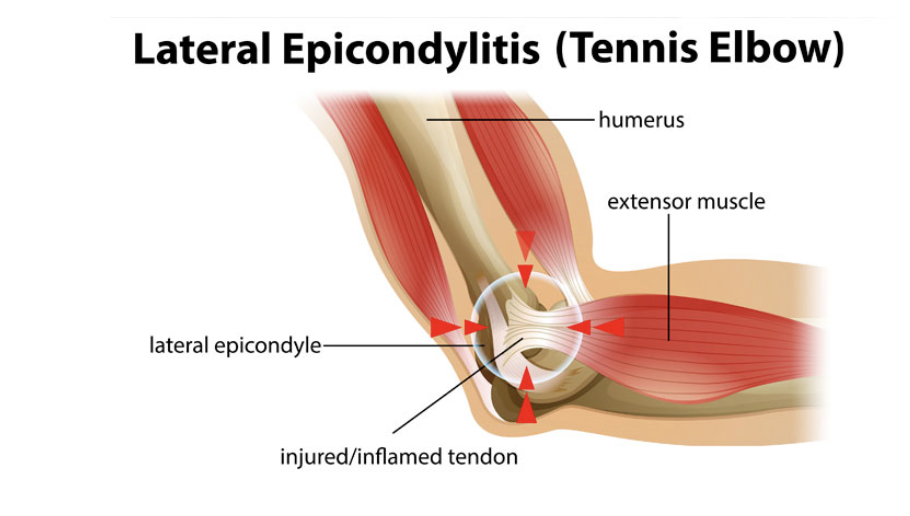Tennis Elbow: Pain in Every Stroke
Editor: Everett Chi
What is tennis elbow?
Tennis elbow is a form of tendonitis, or inflammation of the tendons, commonly referred to as lateral epicondylitis. It is characterized by a sharp, persistent pain in the outer elbow, weakened grip strength, and tenderness in the forearm.
Anatomy Behind the Injury:
The tendons involved in tennis elbow attach your forearm muscles to the lateral epicondyle, a bony bump on the outer side of the elbow. It allows the extensor forearm muscles to lift the wrist and extend the fingers.
The main tendon involved is called the extensor carpi radialis brevis (ECRB) tendon. It is located deep in the forearm and stabilizes our wrists when clenching our fists—gripping a tennis racket, holding an object, or turning a doorknob.
Tennis elbow stems from microtears and inflammation in the extensor muscles, fostering a sharp pain whenever the tendon is utilized. The pain becomes more severe when the wrist or fingers are extended, especially when faced with resistance.In severe cases of tennis elbow, the tendon can partially detach from the lateral epicondyle. This generally only occurs when the tendon is continuously strained without time to heal.
Cause:
Tennis elbow is primarily caused by repetitive motions: gripping, twisting the wrist and forearms, and extending fingers, all of which strain the extensor tendons. The continuous contraction of the forearm muscles and extension of the wrist builds tension in the tendons faster than they can be repaired. Over time this weakens the tendon fibers, causing microtears and tissue deterioration.
This is common in athletes who play sports that involve swinging a club or racket—tennis, badminton, golf, and pickleball. However, it is not limited to only athletes. Repetitive motion from daily activities or exercises can also lead to the development of tennis elbow.
Age and other factors play a role in the manifestation of tennis elbow. It is more common for adults aged 30 to 50 to develop the injury because their tendons are more susceptible to damage. Additionally, improper technique when swinging a racket can place more strain on the forearm muscles and tendon, causing greater damage to the fibers.
Prevention:
The best ways to prevent tennis elbow are:
Warm up properly before playing sports or exercising. This includes stretching and gradually easing into the sport or workout. Muscles are more prone to stress when they are not warmed up.
Take breaks and avoid overusing forearm muscles. It allows the muscles to relax and reduces the strain on them. It is especially important to take breaks when doing repetitive motions such as swinging a racket or club.
Train your forearm. Performing wrist flexion and and extension exercises strengthen the forearm muscles. This makes them more resilient to strain and microtears.
Use proper racket or lifting techniques. By learning how to swing or lift properly, the strain and damage inflicted upon the arms and elbows can be reduced.
Reduce or stop usage of the elbow, forearm, and wrist if experiencing discomfort. Continued use of muscles in these areas will only increase pain and inflammation.
Treatment:
The first and most important step of recovery is to rest, as well as reduce contraction and movement of the forearm muscles. Any additional strain on the muscles will only weaken the extensor tendons further.
Some common tips to aid healing:
Ice and anti-inflammatory medication to reduce swelling
Wearing a brace or taping to relieve tension on the tendon
Physical therapy to strengthen the forearm muscles and increase flexibility
In severe cases, surgery or corticosteroid injections may be necessary to reduce inflammation and resolve the pain.
Sources:
Carofino, Brad. “10 Tips for Preventing Tennis Elbow.” Dr. Carofino, https://www.drcarofino.com/blog/10-tips-for-preventing-tennis-elbow.
Mayo Clinic Staff. “Tennis Elbow: Diagnosis and Treatment.” Mayo Clinic, https://www.mayoclinic.org/diseases-conditions/tennis-elbow/diagnosis-treatment/drc-20351991.
InformedHealth.org. “Overview: Tennis Elbow.” National Center for Biotechnology Information, https://www.ncbi.nlm.nih.gov/books/NBK506998/.
American Academy of Orthopaedic Surgeons. “Tennis Elbow (Lateral Epicondylitis).” OrthoInfo, https://orthoinfo.aaos.org/en/diseases--conditions/tennis-elbow-lateral-epicondylitis/.
https://www.opaortho.com/wp-content/uploads/2024/08/stretching-exercises-for-flexibility.png


